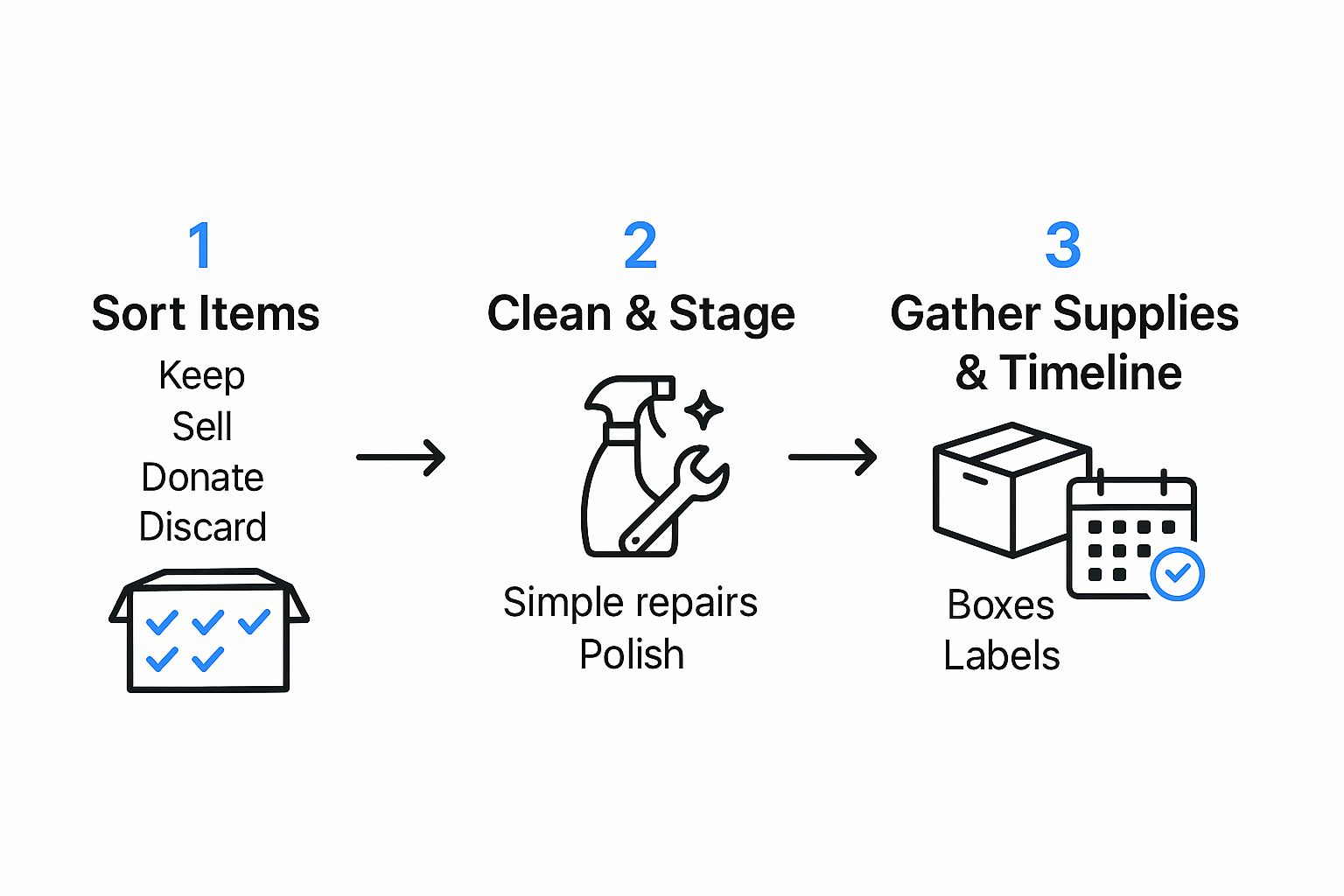Your Guide to a Successful Estate Sale Austin

Before you even think about pricing grandma’s antique china, you need to get a read on the local real estate climate. Running a successful estate sale in Austin isn’t just about the items you’re selling; it's about understanding the environment you're selling in. The city's housing inventory and fluctuating prices create a very specific set of challenges and opportunities that will directly shape how your sale plays out.
Understanding the Austin Market for Your Estate Sale

Taking a beat to understand the local market is one of the smartest things you can do. Your estate sale doesn’t exist in a bubble—it’s directly tied to the rhythm of Austin’s real estate scene. When homes are flying off the market, you have a flood of new buyers eager to furnish their spaces. When things cool down, you have to be a bit more strategic.
This context is gold, whether you're handling an inheritance from another state or clearing out your own home to list it. It grounds your expectations in reality and helps you make better decisions on everything from timing to pricing right from the start.
Navigating Austin's Buyer's Market
The Austin housing market has shifted dramatically, and that has a ripple effect on anyone looking to liquidate assets. The latest data shows we're firmly in a buyer's market, which changes the game for your estate sale.
As of June 2025, Austin was swimming in roughly 17,163 active residential listings—that’s a near-record high. At the same time, the median sold price had dipped to $450,000, a significant drop from the $550,000 peak just two years ago. With over half of those listings sitting vacant and more than 53% getting price cuts, it’s clear who has the upper hand. You can dig into the full Austin housing trends to see exactly how we got here.
So, what does this actually mean for your sale?
- More Competition: A glut of homes for sale often means more people are moving or downsizing. That can translate to more estate sales competing for buyers' attention.
- Price-Savvy Shoppers: As home prices come down, people are more budget-conscious. Your pricing needs to be sharp and competitive to move inventory.
- A Built-In Audience: That high number of vacant listings? That's your opportunity. It means a steady stream of new residents will be looking for furniture and décor to fill those empty rooms.
It’s not just about selling stuff. It’s about selling stuff into a specific economic moment where buyers have more power and more choices than they’ve had in years. Understanding that dynamic is key.
Before we go further, let's break down how these market stats directly impact your planning.
Austin Market Snapshot for Estate Sale Planning
This table summarizes the key indicators in Austin and connects them directly to your estate sale strategy, helping you see the "why" behind our advice.
| Market Indicator | Current Status | Impact on Your Estate Sale |
|---|---|---|
| Active Listings | 17,163 (Near-record high) | High competition, but also a large pool of new homeowners needing to furnish their properties. |
| Median Sold Price | $450,000 (Down from $550k) | Buyers are more price-sensitive. Competitive starting bids and fair "Buy It Now" prices are crucial. |
| Price Reductions | Over 53% of listings | Signals a buyer's market. Your items need to be perceived as a good value to attract bids. |
| Vacant Listings | Over 50% | Huge opportunity. Market directly to new movers who need everything from sofas to silverware. |
Seeing the data laid out like this makes it clear: a buyer-friendly real estate market is actually a fantastic opportunity for a well-run estate sale, as long as you plan for it.
How Market Conditions Shape Your Strategy
This kind of market forces you to be thoughtful. If you're clearing out a home to sell it, for example, the estate sale becomes a mission-critical first step. A great sale doesn't just put cash in your pocket; it leaves the home empty, clean, and ready for those all-important real estate photos.
Your strategy has to assume that your shoppers are smart. They've been scrolling Zillow, they're comparing prices online, and they know a good deal when they see one. Aligning your sale's timing and pricing with these market realities is the bedrock of a profitable event.
A Practical Checklist for Pre-Sale Preparation
A profitable sale is born from deliberate preparation, not last-minute scrambling. Honestly, success hinges on a systematic approach that turns a mountain of belongings into organized, sellable inventory. This isn't just about tidying up; it's about creating a clear framework for every single item in the home.
The very first step, before you touch a single box, is to secure all personal items. Go find and consolidate important documents—wills, titles, financial records—and irreplaceable family photos or heirlooms. Get these set aside in a secure, off-site location so they don't get accidentally sold or misplaced in the controlled chaos of sale prep.
Once those personal effects are safely out of the way, you can dive into the sorting process. This is the real foundation of your entire estate sale in Austin and it deserves your full attention.
The Four-Box Sorting Method
The most effective way I've seen to tackle a house full of possessions is to categorize everything. Go room by room and force yourself to assign every item to one of four destinations: Keep, Sell, Donate, or Discard. This simple method forces a decision and stops you from just shuffling the same items around over and over.
- Keep: These are the items with sentimental value or personal use that will absolutely not be part of the sale.
- Sell: Anything with resale value that you're ready to part with. This is your inventory.
- Donate: Usable items that might not fetch a good price but can definitely benefit a local Austin charity.
- Discard: Broken, expired, or unsanitary items that simply can't be sold or donated.
This part of the process can be emotionally taxing, so give yourself some grace and take it one room at a time. It’s a marathon, not a sprint. To keep everything organized as you go, our comprehensive estate sale checklist is a lifesaver—it provides a downloadable guide to track your progress.
Cleaning and Staging for Maximum Appeal
After you’ve sorted everything, it's time to make that "Sell" pile shine. A little bit of elbow grease here can dramatically increase an item's final price. You'd be surprised how much of a difference even a simple cleaning can make in how buyers perceive its value.
Dust the furniture, polish any silver, and wash glassware until it sparkles. For furniture with minor scuffs, a quick touch-up with a wood marker can work wonders. Be sure to test any electronics to ensure they're in working order and label them accordingly. Staging isn't about redecorating the whole house; it's just about presenting items in their best possible light.
This infographic below really breaks down this simple yet effective workflow.

Breaking an overwhelming task into this visual process—Sort, Clean, and Plan—turns it into a series of much more manageable stages.
Gathering Supplies and Setting a Timeline
Finally, it’s time to get your logistics in order. Create a master list of all the supplies you'll need: boxes, pricing labels, markers, cleaning products, and cash for making change on pickup day.
Setting up a realistic timeline is also vital. My advice is to work backward from your desired sale date, scheduling dedicated weekends for sorting, cleaning, and pricing.
A well-planned timeline is your best defense against pre-sale stress. It ensures you have enough buffer to handle unexpected delays without compromising the quality of your sale preparation.
If this estate sale is part of a bigger plan to relocate out of state, this prep phase is even more critical. Getting organized for the sale can dovetail perfectly with your moving plans. This ultimate interstate moving checklist is a great resource to help ensure all aspects of your move are covered seamlessly alongside the sale.
Smart Pricing Strategies for Austin Buyers

Pricing your items is where the rubber meets the road. It’s a delicate dance between strategy and psychology, especially in a market as vibrant and specific as Austin's. Your goal is to find that sweet spot—high enough to maximize your return, but low enough to attract eager buyers and create momentum. It takes a little research and a solid understanding of what makes local shoppers open their wallets.
Before you even think about tagging an item, you need to become a student of the local market. Spend a weekend browsing Austin-area Facebook Marketplace, Craigslist, and even the "sold" listings on eBay filtered by location. This isn't about what you hope an item is worth; it's about seeing what similar things are actually selling for right now.
Researching Real-World Austin Values
For common household goods, this part is pretty straightforward. A quick search for "used Crate & Barrel wine glasses" or "West Elm coffee table Austin" will give you a solid baseline in minutes. Pay attention to the condition and asking prices to see where your items fit in.
But for those unique, high-demand pieces that Austin buyers crave—like that classic mid-century modern furniture—you need to dig a bit deeper. Look for a maker's mark or label. A "Broyhill Brasilia" dresser is in a completely different league than a generic unbranded piece, and your price needs to reflect that. Doing this homework is what separates a good estate sale in Austin from a great one.
The single biggest pricing mistake is letting sentimental value creep in. A buyer has no connection to what you paid for something ten years ago. They only care about what it's worth to them today. Stick to objective, data-backed pricing—it always wins.
Balancing Firm Prices and Volume Sales
You shouldn't price everything with the same philosophy. A smart sale uses a mixed strategy to get the best overall result. Some items are your headliners, while others are just supporting cast meant to move out the door.
- Unique Treasures: Have a rare piece of art, a signed first-edition book, or some high-end designer furniture? Set a firm, well-researched price. These are your anchor items, and you shouldn't be in a rush to discount them.
- Everyday Goods: For things like kitchen gadgets, linens, and basic tools, price them to sell. The goal here is volume. Buyers love the thrill of a bargain, and clearing out these smaller items quickly builds excitement and frees up space.
This is also a great time to get creative with bundling. Grouping a set of garden tools or a collection of cookbooks for a single price is a fantastic way to sell more with less hassle. For a deeper dive into these tactics, our complete estate sale pricing guide has even more advanced tips.
Recognizing High-Value Assets
Every now and then, you'll stumble across something you think might be valuable but aren't quite sure. Before you slap a price tag on it and potentially leave thousands on the table, it's worth getting a professional appraisal. This is especially true for fine jewelry, original art, sterling silver, or genuine antiques.
This is critical in Austin's high-end market. For perspective, recent reports show the median sales price for luxury homes in Austin hitting $2,000,000, with properties selling for nearly 95% of their asking price. This tells you there's a local clientele with serious purchasing power, but they're also savvy. An official appraisal gives you the data and the confidence you need to price your top-tier items for this audience and stand firm during negotiations.
Marketing That Attracts Eager Shoppers

You can have the most incredible collection of treasures, but it won't sell itself. If nobody knows about your sale, all that hard work preparing goes to waste. A smart, focused marketing plan is what turns your event into a can't-miss destination for serious buyers. The goal is simple: create buzz, build a little urgency, and get a crowd lined up, ready to shop.
For any estate sale in Austin, your marketing needs to hit from two angles: a strong online presence and good old-fashioned physical signs. The digital side reels in the dedicated hunters who plan their weekends around sales, while the signs grab all that valuable drive-by traffic you’d otherwise miss entirely.
Crafting Your Digital Footprint
Your online listing is your single most powerful tool. It’s your first impression, and it's where you convince people that your sale is worth their time and gas money. Start by getting your sale listed on dedicated platforms like EstateSales.net, which is the go-to spot for local enthusiasts.
From there, put social media to work. Find and post in Austin-specific Facebook groups for garage sales, neighborhood pages, and antique collector circles. These are hyperlocal goldmines filled with an audience that's actively looking for exactly what you're selling. For more ideas on expanding your reach, check out these actionable online marketing tips for small businesses.
The secret to a killer online ad is all in the details. Don't just say "furniture for sale." Get specific. "Authentic Mid-Century Modern Broyhill Brasilia Credenza" or "Complete Set of Vintage Le Creuset Cookware" will stop scrollers in their tracks. Specificity sells.
How you present your items visually is just as important as what you write.
- Take Great Photos: Use natural light whenever you can and clear the clutter around the item. A bright, focused photo instantly makes something look more valuable.
- Showcase the Stars: Your best stuff—like designer furniture, cool collectibles, or high-end electronics—should be the very first photos in your listing. Lead with your best.
- Create a Full Gallery: A solid listing has dozens of pictures. You want to give shoppers a comprehensive preview that gets them excited and helps them plan their attack.
If you want to dive deeper, our complete guide to estate sale marketing gives you the full blueprint for getting the word out.
The Power of Old-School Signage
Never, ever underestimate the power of a few well-placed signs. They are absolutely essential for guiding people to your front door on sale day.
Keep your signs simple, bold, and easy to read from a moving car. We're talking thick, dark marker on brightly colored poster board.
Before you put a single sign up, make sure you check the City of Austin's local ordinances. Placing them on utility poles, traffic signs, or in public medians will usually land you a fine. Stick to major intersections near your home and use big, clear arrows to point the way right to your sale.
Here’s the rewritten section, crafted to match the human-written style and tone of the provided examples.
Running a Smooth and Profitable Sale
When the doors finally open, all your careful prep work is put to the test. A successful sale day isn't about luck—it's about smart execution. Your main goals are simple: create a great shopping experience, keep the checkout line moving, and make sure both your items and your guests are safe.
The first thing to think about is traffic flow. You'll want to arrange your rooms and displays to create an obvious path through the house, avoiding those frustrating bottlenecks that can happen in tight hallways or small rooms. Place your best stuff in well-lit, prominent spots to draw people in and guide them along. Think of it like a retail store—you want to encourage people to browse, not get stuck in a jam.
Managing Payments and Security
A fast, easy checkout is absolutely critical. While a lot of shoppers at an estate sale in Austin still carry cash, you can’t afford to ignore digital payments. Make sure you have plenty of small bills for change, but also set up a QR code for Venmo or PayPal. This little bit of flexibility can be the difference between making a sale and having someone walk away empty-handed.
Security is another piece you can't overlook. It’s always a good idea to have a friend or family member help out, positioning them in key areas or near the exit. For your really valuable or small items—like jewelry, coins, or other collectibles—keep them right by your checkout station in a locked display case where you can always have an eye on them.
The energy of the day is contagious. A calm, organized, and friendly atmosphere not only makes the experience better for shoppers but also helps you stay in control and make clearer decisions during negotiations.
The Art of Negotiation
Let's be honest, haggling is part of the fun at an estate sale. Shoppers are hunting for a deal, and you’re trying to get a fair price. The trick is knowing when to stand firm and when to be a little flexible to maximize your profits without losing a sale.
Here are a few tips I've learned for handling the back-and-forth:
- Know Your Bottom Line: Before the sale even starts, decide on a firm "no-haggle" price for your most popular or unique items.
- Offer Bundle Deals: If a buyer is looking at a few different things, offer a small discount if they take the whole lot. It’s a fantastic way to move more inventory at once.
- Use the Clock to Your Advantage: As you get into the final day, or even the last few hours, be more willing to negotiate. Your goal starts shifting from getting top dollar to simply clearing out the house.
This dynamic is what keeps the Austin market buzzing. In June 2025 alone, the city saw 979 closed home sales, a 12.9% jump from the year before, with a total dollar volume of over $770.6 million. All that activity means there's a constant flood of new homeowners looking to furnish their spaces. You can learn more about how the Central Texas housing market fuels this demand for well-run sales.
Got Questions About Your Austin Estate Sale? We've Got Answers.
As you get closer to your sale dates, the big-picture planning gives way to those small, nagging questions. You know the ones—the "what if" scenarios that can trip you up if you're not prepared.
We've been there, and we've heard it all. Think of this as your go-to FAQ for running a smooth estate sale in Austin. Getting these details sorted out now means less stress and more confidence when it matters most.
Do I Need a Permit for an Estate Sale in Austin?
This is probably the number one question we hear, and thankfully, the answer is pretty simple. For a standard estate sale at a private home, the City of Austin does not require you to get a special permit. They treat it just like a garage sale.
Under current rules, most homes are allowed two sales per year, and each one can last for up to three consecutive days. The biggest thing you need to watch out for is your signage.
Never, ever attach your signs to city property like utility poles, traffic signs, or medians. It's the fastest way to get them taken down and maybe even earn a fine. It’s always smart to do a quick search for the latest City of Austin garage sale ordinances before you start, just to be safe.
How Should I Handle Valuable Jewelry or Art?
If you've uncovered some fine jewelry, original artwork, or rare collectibles, hitting the brakes is the right move. Trying to sell these high-value items in a general estate sale is a massive gamble—you could be leaving serious money on the table.
First things first: get a professional appraisal. This isn't optional. An appraiser gives you a documented, defensible value, which is critical for both pricing and insurance. Once you know exactly what you have, you’ve got a few great options:
- Consignment: Partner with a respected Austin consignment shop that specializes in fine art or luxury goods.
- Auction House: For truly rare pieces, a dedicated auction house can market them to a worldwide audience of serious buyers.
- Private Dealer: You can also sell directly to a reputable local dealer who knows the market for your specific item.
If you absolutely must include these items in your main sale, security is key. Keep them in a locked display case right at your checkout station. Stick to your appraisal-backed price and don't let anyone pressure you into a lowball offer.
What's the Best Plan for Unsold Items?
Let's be realistic: you won't sell every single thing. The key is to have a solid plan for the leftovers before the sale even begins. Waiting until the last minute will only create chaos.
A multi-step approach works best here. Before the sale, research and schedule a pickup with a local charity like Goodwill Central Texas or Austin Pets Alive! Thrift. For anything that's broken or can't be donated, get a quote from a junk removal service and have them on standby.
Here’s a great pro-tip: for the final hour of your sale, announce that anything left is free for the taking. You'd be amazed how much of your remaining inventory will simply walk out the door, saving you the hassle of dealing with it later.